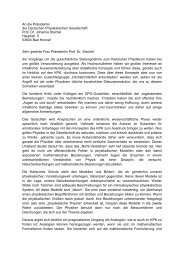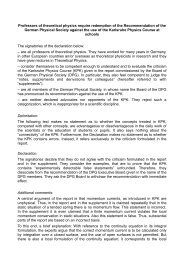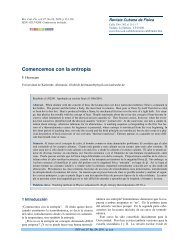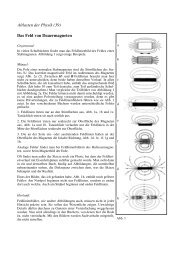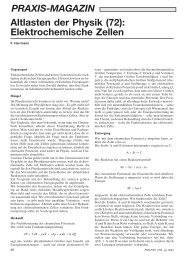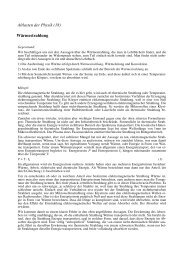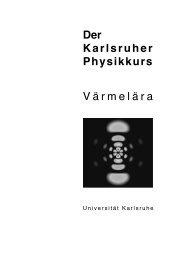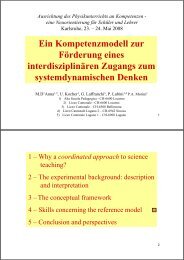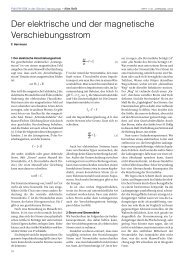Historical burdens on physics 83 Muscular force
Historical burdens on physics 83 Muscular force
Historical burdens on physics 83 Muscular force
Create successful ePaper yourself
Turn your PDF publications into a flip-book with our unique Google optimized e-Paper software.
<str<strong>on</strong>g>Historical</str<strong>on</strong>g> <str<strong>on</strong>g>burdens</str<strong>on</strong>g> <strong>on</strong> <strong>physics</strong><br />
<strong>83</strong> <strong>Muscular</strong> <strong>force</strong><br />
Subject:<br />
“Although we may have already an intuitive idea of a <strong>force</strong> as a push or a<br />
pull, like that exerted by our muscles… Newt<strong>on</strong>’s laws allow us to refine our<br />
understanding of <strong>force</strong>s.” [1]<br />
“We all have a fairly deep intuitive understanding of what <strong>force</strong>s are and<br />
what effect they have <strong>on</strong> objects. We are c<strong>on</strong>stantly using our muscles to<br />
exert <strong>force</strong>s: we pull up <strong>on</strong> a coffee cup to get it to our mouths, we push<br />
against a car stuck in a ditch in order to get it moving and we exert a <strong>force</strong><br />
to stop a basketball as we catch it.” [2]<br />
“The c<strong>on</strong>cept of <strong>force</strong> can be traced back to our muscular sensati<strong>on</strong>.” [3]<br />
Deficiencies:<br />
We perceive the actuati<strong>on</strong> of our muscles as an effort. We do not perceive it<br />
as a specific sensory percepti<strong>on</strong> but as an act of voliti<strong>on</strong>. But for which<br />
physical quantity can this effort be c<strong>on</strong>sidered a measure? On the <strong>on</strong>e hand<br />
a <strong>force</strong> is acting as l<strong>on</strong>g as the muscle is tended. On the other the muscular<br />
activity needs energy. ATP is transformed into ADP, regardless of whether<br />
our muscles move something (deliver mechanical work) or not (i.e. <strong>on</strong>ly<br />
produce heat). Thus, our muscular sensati<strong>on</strong> points to a <strong>force</strong> (a momentum<br />
current) just as much as to an energy current, i.e. to the physical quantity<br />
power. Since in the teaching of <strong>physics</strong> the c<strong>on</strong>cepts <strong>force</strong> and power<br />
are often c<strong>on</strong>founded, we believe that it is not wise to appeal to the muscular<br />
sensati<strong>on</strong> when introducing the c<strong>on</strong>cept of <strong>force</strong>.<br />
Origin:<br />
There is reas<strong>on</strong> to suspect that the muscular sensati<strong>on</strong> is put forward because<br />
<strong>on</strong>e might take the muscles for the cause or the causer of the <strong>force</strong>.<br />
Let us c<strong>on</strong>sider an example: Who or what is the cause of the <strong>force</strong> in the<br />
string in Fig. 1a? Our immediate feeling may be that it should be the spring.<br />
And in Fig. 1b? Shouldn’t is be the manikin with its muscles? This feeling<br />
brings us to say: “The spring pulls”, or “The manikin pulls”. We do not say:<br />
“The string pulls”, or “The wall pulls”. But something must be wr<strong>on</strong>g with<br />
these statements. We c<strong>on</strong>sider Fig. 1c. Here, which of the two springs<br />
would be resp<strong>on</strong>sible for the <strong>force</strong>, which <strong>on</strong>e would be the cause of the<br />
<strong>force</strong>? And which <strong>on</strong>e of the two manikins in Fig. 1d? Finally, we can also<br />
c<strong>on</strong>sider the string to be a spring with a very great spring c<strong>on</strong>stant. Thus,<br />
our procedure to find the cause of the <strong>force</strong> does not work. So the questi<strong>on</strong><br />
is: But can it be that our feeling has cheated us? Isn’t there really nothing<br />
that distinguishes the spring or the manikin from the rest of the arrangement?<br />
Yes, there is. Both, the spring and the manikin can act as a source of<br />
mechanical energy. And therefore they appear to our feeling as the origin,<br />
the resp<strong>on</strong>sible, the causer of what we observe. Actually, they must not deliver<br />
mechanical energy, they <strong>on</strong>ly must be able to deliver it. Thus, if we<br />
make them resp<strong>on</strong>sible for the <strong>force</strong>, we miss the target.
a<br />
b<br />
c<br />
d<br />
Fig. 1. (a) Is the spring the cause of the <strong>force</strong>? (b) Is the manikin the cause of the<br />
<strong>force</strong>? (c) Which of the two springs would be the cause of the <strong>force</strong>? (d) Which of<br />
the two manikins would be the cause of the <strong>force</strong>?<br />
Disposal:<br />
Actually, we are perfectly able to perceive <strong>force</strong>s that act <strong>on</strong> our body. Nature<br />
has equipped us with special sensory organs for the purpose. In our<br />
skin we have sensors for compressive, tensi<strong>on</strong>al and shear stress, which<br />
are as reliable for the measurement of <strong>force</strong>s as other sensors in our body<br />
are reliable for the „measurement“ of other physical quantities: temperature,<br />
light intensity and sound intensity. In this way we can feel <strong>force</strong>s, regardless<br />
of whether our muscles are active or not. We can even get a rather good<br />
idea of the unit of <strong>force</strong>: A slight pressure <strong>on</strong> our skin with <strong>on</strong>e finger, or also<br />
a 100-g-weight placed <strong>on</strong> our arm corresp<strong>on</strong>ds to <strong>on</strong>e Newt<strong>on</strong>.<br />
[1] Paul A. Tipler and Gene Mosca, Physics – for Scientists and Engineers,<br />
Sixth editi<strong>on</strong>, W. H. Freeman and Company, New York, 2008, p. 93.<br />
[2] http://theory.uwinnipeg.ca/mod_tech/node20.html<br />
[3] Cited from a German school book<br />
Friedrich Herrmann, Karlsruhe Institute of Technology





